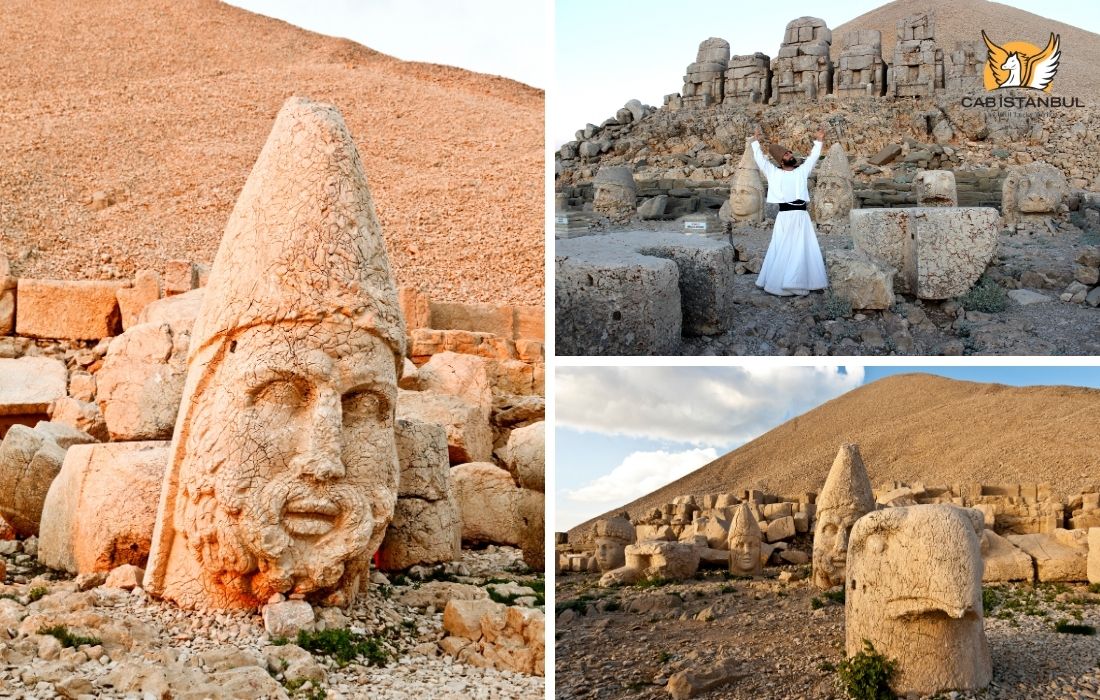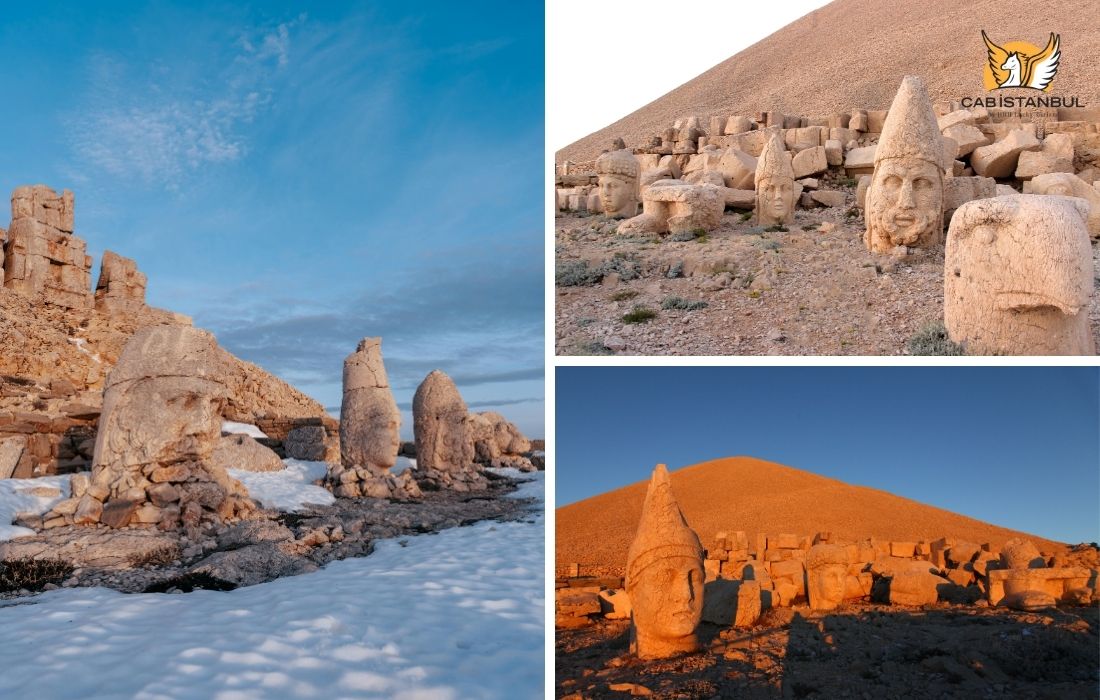Things to Do in Mount Nemrut
2025-12-06

Mount Nemrut -Kommagene Kingdom
Mount Nemrut is one of the world’s most awe-inspiring archaeological wonders, offering a unique blend of Persian and Greek cultural legacies. This UNESCO World Heritage Site is the crown jewel of the ancient Kommagene Kingdom, a Hellenistic dynasty that flourished between 163 BC and 72 AD. Perched at an altitude of 2,150 meters, Mount Nemrut served both as a religious and political hub, strategically linking Syria, Mesopotamia, and Anatolia.
The site’s most iconic feature is the massive temple-tomb complex built by King Antiochus I, who declared himself a god-king and fused deities such as Zeus, Apollo, Mithras, and Ahura Mazda. The colossal statues, measuring 8–10 meters high, stand solemnly on the eastern and western terraces, forming one of the most fascinating open-air sanctuaries in the ancient world.
Today, things to do in Mount Nemrut range from witnessing unforgettable sunrises and sunsets between stone gods to exploring nearby relics like Arsameia, the Karakuş Tumulus, and the Cendere Bridge. The dramatic heads that have toppled from their original statues offer an eerie, yet majestic presence—photographers, historians, and travelers alike are captivated.
Visitors can stay in nearby towns like Kahta or Adiyaman, with hotel options ranging from luxury to local guesthouses. The best times to visit are spring and autumn, as the high elevation can bring extreme weather conditions. Whether you are an adventurer, a spiritual seeker, or a culture lover, Mount Nemrut offers a timeless journey into a forgotten realm.
Explore the mystery, art, and astronomy that shaped a kingdom. Discover the legends of Kommagene, and let Mount Nemrut transport you to an ancient world where East met West in stone and sky.
Book our private chauffeur-driven car rental in İstanbul or private transfer service for a seamless journey to Mount Nemrut. Travel comfortably from Adiyaman or Gaziantep airports with professional drivers and modern vehicles, tailored to your schedule and sightseeing needs.
Mount Nemrut National Park
The Kingdom of Commagene
The Kingdom of Commagene was a small but culturally rich Hellenistic kingdom located in present-day southeastern Turkey, particularly around modern Adiyaman. It existed from 163 BC to 72 AD and served as a vital link between the East (Persian Empire) and the West (Greek and Roman civilizations)
Historical Timeline-Kingdom of Commagene
From Seleucid Origins to Independence- Commagene began as a part of the Seleucid Empire, one of the successor states after the breakup of Alexander the Great's empire. It gained independence in 163 BC under King Ptolemaeus, who established the royal dynasty.
Golden Age under Antiochus I (70–38 BC)- King Antiochus I Theos elevated Commagene to its peak, blending Persian and Greek traditions. He styled himself as a divine ruler, commissioning grand monuments, including the sanctuary at Mount Nemrut. His reign is considered the kingdom’s cultural zenith.
End of the Kingdom-In 72 AD, Roman Emperor Vespasian annexed Commagene into the Roman Empire, transforming it into a Roman province. Despite losing independence, its cultural legacy remained embedded in its monuments and inscriptions.
🏔️ Mount Nemrut: Throne of the Gods-Mount Nemrut is located near the town of Kahta in Adiyaman Province and stands at 2,150 meters above sea level. It was chosen as the site of Antiochus I's burial and became a sacred site in Commagene's spiritual landscape.
🗿 The Tomb-Sanctuary of Antiochus I-Monumental Design-The centerpiece of Mount Nemrut is a massive burial mound (tumulus) made of crushed rock, hiding the tomb of King Antiochus I. The tumulus is flanked by two terraces (east and west), each lined with colossal statues representing gods, animals, and the king himself.
Statues and Iconography-The statues, 8–10 meters tall, depict:
Zeus-Oromasdes (fusion of Greek Zeus and Persian Ahura Mazda)
Apollo-Mithras-Helios-Hermes
Herakles-Ares-Artagnes
Tyche of Commagene
King Antiochus I Theos himself
Each statue reflects the cultural synthesis that defines Commagene art.
🌅 Symbolism and Sacred Rituals-Divine Kingship-Antiochus claimed divine ancestry from both Alexander the Great and Darius I of Persia. The sanctuary at Mount Nemrut was not just a burial site but a place for celestial worship, royal propaganda, and cultural unity.
Astronomical Alignments-Some scholars believe that the monument aligns with specific celestial events, especially the summer solstice. The famous “Leo Horoscope” relief, showing a lion with celestial symbols, is considered one of the oldest known astrological representations.
🏺 Inscriptions and Epigraphy-Nomos Inscriptions- Detailed inscriptions, or "nomos," explain Antiochus's religious beliefs, philosophy, and instructions for rituals to be performed at Nemrut. These texts provide insight into the royal ideology and governance of Commagene.
🏞️ Other Commagene Archaeological Sites-Arsameia
The ancient summer capital of Commagene, featuring reliefs and the famous “Handshaking Relief” symbolizing royal diplomacy.
Karakuş Tumulus-Burial monument for royal women of Commagene, marked by a column topped with an eagle sculpture.
Cendere Bridge-An ancient Roman bridge built with Commagene support, still standing today.
🗺️ Strategic and Geopolitical Role-Buffer State Between Rome and Parthia-Commagene’s location made it a valuable buffer zone between two superpowers. The kingdom leveraged diplomacy and cultural diversity to maintain semi-autonomy for over a century.
🏨 Tourism and Accessibility Today-UNESCO World Heritage Site-Mount Nemrut was designated a UNESCO site in 1987 due to its historical and cultural significance. The site is now a major destination for cultural and adventure tourism.
Best Time to Visit-Spring (April–May) and autumn (September–October) are ideal due to cooler weather and clear skies for sunrise/sunset views over the statues.
Kng Antiochus

he Mystery of Mount Nemrut's Colossal Statues
The statues on Mount Nemrut are among the most enigmatic and impressive archaeological artifacts in the ancient world. Towering between 8 and 10 meters high, they are located on the eastern and western terraces of the mountain. But who commissioned these statues, and who built them? The answer lies in the cultural, political, and religious ambitions of one remarkable ruler: King Antiochus I Theos of Commagene.
King Antiochus I Theos (Ruler of Commagene)
The Visionary Behind the Project-The monumental statues were commissioned around 62 BC by Antiochus I Theos, the most prominent king of the Kingdom of Commagene. He ruled between 70 and 38 BC and envisioned a syncretic kingdom uniting Persian and Greek traditions. By erecting these statues, Antiochus intended to:
Deify himself alongside gods
Reinforce his divine ancestry
Create a sacred space for religious rituals
Leave an eternal legacy of his rule
The statues were part of a larger project: a funerary monument and temple-tomb complex (hierothesion) built atop the 2,150-meter-high Mount Nemrut.
A Fusion of Persian and Greek Influences
Dual Cultural Symbolism-The artistic style of the statues reflects the unique cultural identity of Commagene. Antiochus aimed to combine:
Persian spiritual elements, like Ahura Mazda and Mithras
Greek deities and aesthetics, including Zeus, Apollo, and Herakles
This fusion is evident in the names and depictions of the deities on the statues (e.g., Zeus-Oromasdes, Apollo-Mithras-Helios, Herakles-Artagnes-Ares). It also shows Antiochus's effort to emphasize divine legitimacy from both Greek and Persian bloodlines.
Who Do the Statues Depict?
The statues represent both gods and royalty. They include:
Zeus-Oromasdes – Supreme god, a fusion of Zeus and Ahura Mazda
Apollo-Mithras-Helios-Hermes – A hybrid of Greek and Persian solar deities
Herakles-Artagnes-Ares – Heroic figure blending Greek and Eastern warrior attributes
Tyche of Commagene – Female personification of fortune and the land
Antiochus I himself – Presented as equal to the gods, seated among them
Guardian Animals – Eagle and lion statues, symbolizing divine protection and royal authority
